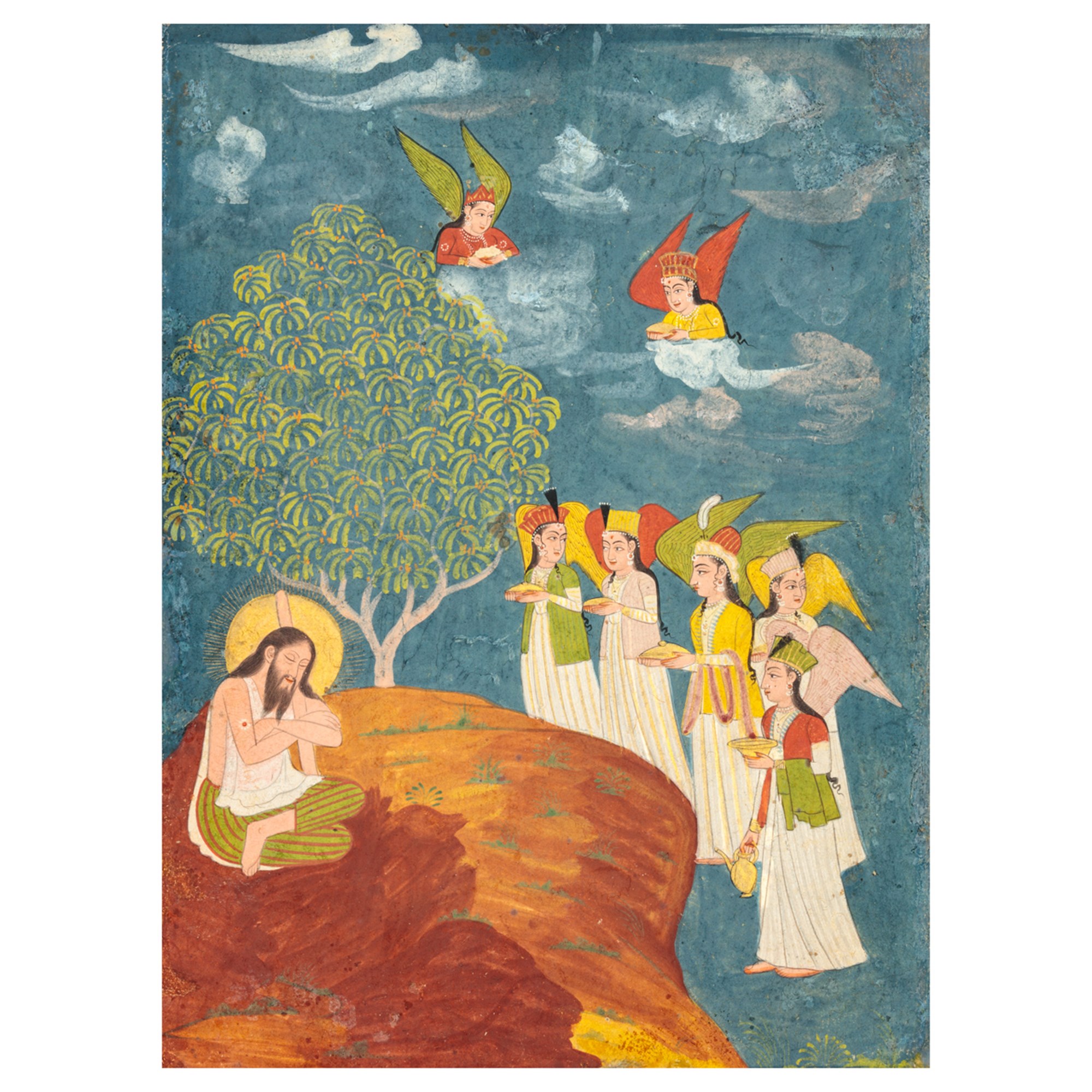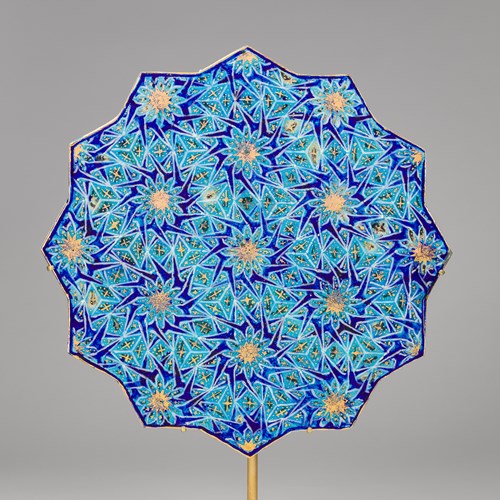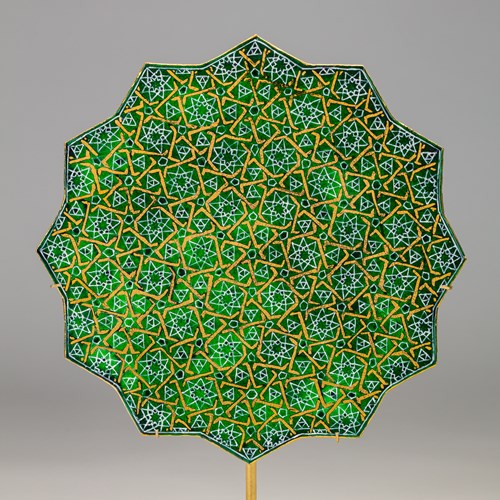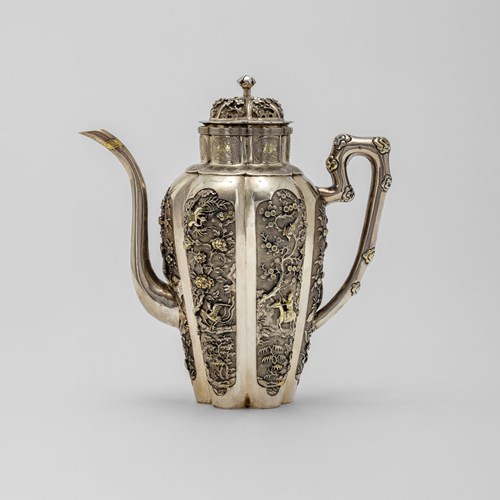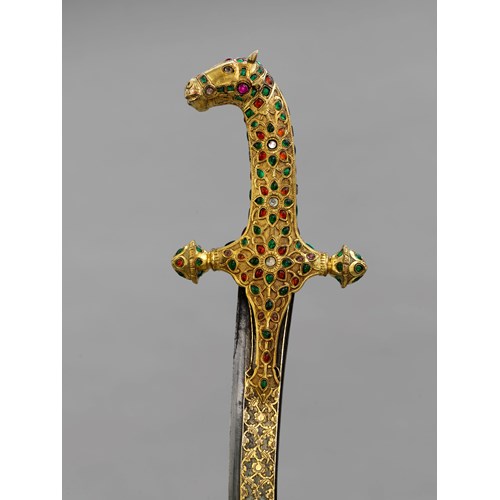Marketplace
Sultan Ibrāhīm Ibn Adham Visited by Angels
Sultan Ibrāhīm Ibn Adham Visited by Angels
Date 1750
Epoque 1750-1850, 18th century
Origine India, Deccan
Dimension 21.5 x 15.5 cm (8¹/₂ x 6¹/₈ inches)
Sultan Ibrāhīm Ibn Adham was an affluent Prince of Balkh (ancient Bactria, now Afghan Turkestan) who presided over a large area of northeast Persia during the eighth century. One night he dreamt that he heard men on the roof of his palace, when he enquired about the incident, he was informed that they we looking for a camel that had strayed. The prince replied that it was ridiculous to search for the camel on the roof, to which he was told it was equally ridiculous to seek Allah in the confines of luxury. The sultan realised that his privileged life was not conducive to his true spiritual destiny. Renouncing his throne, he lived as an ascetic in the wilderness and became a great Sufi master and eminent mystic. The poet Rumi who was also born in Balkh, recorded that Sultan Ibrāhīm was considered a spiritual ancestor of the Chrishtī Sufi order and wrote of him being given food by angles in his six-volume poetic work, the Masnavī.
In this tranquil composition the sultan sits cross-legged beneath a tree at the top of a mountain. His modest attire consists of green and red striped trousers and a cotton sleeveless tunic. As he leans upon his staff one is reminded of his itinerant path while the individual tree further denotes the solitary life of an ascetic. His head tilted forward, eyes gently closed as his face emanates the serenity of a man who has found peace in his heart. A radiant golden halo attests to his divinity. A group of angels approach him, each carrying bowls of food and refreshments. Two further angels fly down from the heavens to donate their offerings. The women’s full cheeks, rosebud lips, almond eyes and soft expressions bear the influence of Persian painting. Black curls of hair tumble down their slender frames and their soft pastel coloured tunics compliment the colours of their wings. The women wear delicate pearl earrings and hats decorated with feathers and pearls. Their beneficence towards the sultan infers divine acknowledgement and is testament to his humble path.
In the middle of the 18th century paintings of Ibn Adham became increasingly popular, especially amongst the ateliers of the Nawabs of Oudh in Lucknow and Faizabad and in the Sultanates of the Deccan. It was also a popular theme in Mughal painting. The compositions were inspired by images of Christ fed by angels in the wilderness, particularly Evangelicae Historiae Imagines, a book of religious engravings produced in Antwerp in 1593. These images were then used to illustrate bibles brought to the Mughal courts by the Jesuits.
As the angles glide down from the heavens to bestow their offerings and Ibn Adham sits in quiet repose, the mood is one of peaceful contemplation. Evoking an aura of tranquillity, the sultan appears as a true spiritual master, renown for a teaching that emphasised stillness and meditation.
Stock no.: A4965
In this tranquil composition the sultan sits cross-legged beneath a tree at the top of a mountain. His modest attire consists of green and red striped trousers and a cotton sleeveless tunic. As he leans upon his staff one is reminded of his itinerant path while the individual tree further denotes the solitary life of an ascetic. His head tilted forward, eyes gently closed as his face emanates the serenity of a man who has found peace in his heart. A radiant golden halo attests to his divinity. A group of angels approach him, each carrying bowls of food and refreshments. Two further angels fly down from the heavens to donate their offerings. The women’s full cheeks, rosebud lips, almond eyes and soft expressions bear the influence of Persian painting. Black curls of hair tumble down their slender frames and their soft pastel coloured tunics compliment the colours of their wings. The women wear delicate pearl earrings and hats decorated with feathers and pearls. Their beneficence towards the sultan infers divine acknowledgement and is testament to his humble path.
In the middle of the 18th century paintings of Ibn Adham became increasingly popular, especially amongst the ateliers of the Nawabs of Oudh in Lucknow and Faizabad and in the Sultanates of the Deccan. It was also a popular theme in Mughal painting. The compositions were inspired by images of Christ fed by angels in the wilderness, particularly Evangelicae Historiae Imagines, a book of religious engravings produced in Antwerp in 1593. These images were then used to illustrate bibles brought to the Mughal courts by the Jesuits.
As the angles glide down from the heavens to bestow their offerings and Ibn Adham sits in quiet repose, the mood is one of peaceful contemplation. Evoking an aura of tranquillity, the sultan appears as a true spiritual master, renown for a teaching that emphasised stillness and meditation.
Stock no.: A4965
Date: 1750
Epoque: 1750-1850, 18th century
Origine: India, Deccan
Dimension: 21.5 x 15.5 cm (8¹/₂ x 6¹/₈ inches)
Plus d'œuvres d'art de la Galerie


